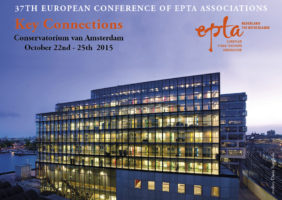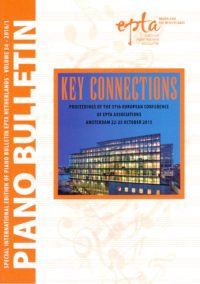As musicians, we often talk about connections: connecting emotionally with certain pieces of music; connecting (or sometimes not) with the audience; connecting with one another when we perform  together; and about connections, or networks, within our profession. And on this blog site I have often written about music and brain connections.
together; and about connections, or networks, within our profession. And on this blog site I have often written about music and brain connections.
So I was delighted to be invited to give a presentation this past October at the 37th conference of the European Piano Teachers Association (EPTA). The conference theme was Key Connections, and it was hosted by EPTA Netherlands and held at the Amsterdam Conservatory, which as you can see in the photo, is housed in a beautiful new building (opened in 2008).
Presenters and attendees came from virtually every country in Europe with an additional few of us from the US, Eastern Europe, South Africa and Israel.
Amsterdam is a marvelously unique city, and from the conservatory, one could look out over the medieval old city centre. But Amsterdam is not a city for pedestrians. Bicycles outnumber people 3:2. I felt as if I were taking my life in my hands each time I walked from our hotel, which was on the west side of Central Station, to the Conservatory, which was several blocks east of the station on Oosterdokseiland (Eastern Dock Island). Bike lanes crisscross in every direction, bicycles come at you from virtually anywhere, and bicyclists just assume dominance of the streets.
But the walk to the conservatory was worth every harrowing step. The conference was a fascinating four days of recitals, lecture-recitals, presentations and workshops. True to the theme of the conference, the recitals explored unusual and fascinating connections between composers and piano repertoire from various countries and time periods (e.g. Cimarosa and Chopin; Rossini and contempory Croatian composer Ivo Josipović) as well as relationships between twentieth-century composers from different countries (e.g. Dutch composer Ton de Leeuw and Turkish composer Ahmet Adnan Saygun).
Presentations and workshops looked at connections between music and any number of other disciplines, including neuroscience, medicine, biomechanics, linguistics, dance, and graphic arts. One evening we rode canal boats to a Walloon church built in 1409 to hear a recital of music of J.S. Bach performed on a Christian Müller organ dating from 1734. The relationship of performer, acoustics, instrument, and setting made for spectacular Bach!
A selection of papers from that conference has just been published as a special international edition of the Piano Bulletin of EPTA Netherlands. My paper,  “What Neuroscience Can Tell Musicians About Learning and Memory,” is included. Much of the content of that paper has been written about in one form or another in earlier posts about learning and memory on this blog.
“What Neuroscience Can Tell Musicians About Learning and Memory,” is included. Much of the content of that paper has been written about in one form or another in earlier posts about learning and memory on this blog.
But if you are interested in revisiting some of that information (as well as additional info) in a different format, or want to check out the other articles concerning the variety of topics mentioned above, click on the article title above or on the Piano Bulletin image. And thank you to EPTA Netherlands for making the link available!!
And by the way, my husband and I continued to dodge bicycles so that we could spend some extra time in Amsterdam visiting the Van Gogh Museum, enjoying the flower markets, walking along the canals, and eating rijsttafel, that elaborate Indonesian meal for which Amsterdam is famous. Tempted as I am to make connections out of all that, I will restrain myself.
2 responses to “Amsterdam and pianists”
Thank you, Lois, for making this available. It’s full of very interesting papers, including your own!
Hi Susan, It’s somewhat unusual for an organization to make Proceedings of a conference available to anyone at no cost, so it’s wonderful that EPTA Netherlands has chosen to do so.